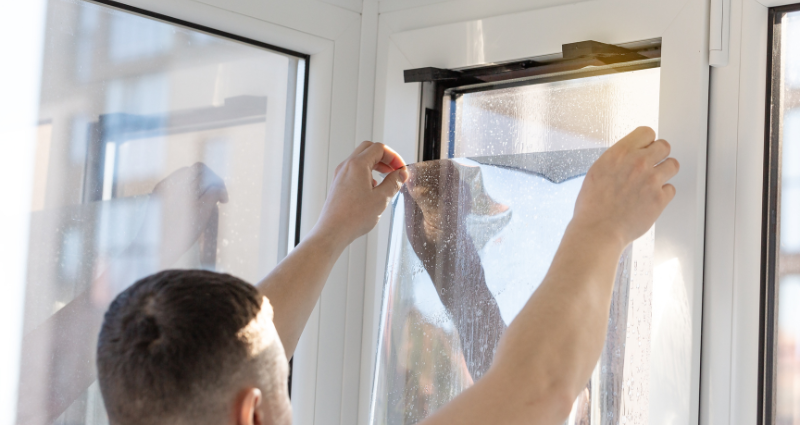Discover Valuable Tax Deductions Available Via Window Film Installation
Window film is well known for its properties of heat reduction, rejecting up to 78% of the sun’s heat and greatly reducing cooling costs for all kinds of properties. The cost savings of solar window film, however, can extend beyond your energy bill. The IRS offers tax credits for energy-efficient efficient property improvements — including certain window films.
How, then, can property-owners gain tax credits for their windows? Keep reading to learn what kinds of windows qualify, alongside the steps property-owners need to take to gain their tax credits.
- Are Windows Tax Deductible?
- How to Gain Tax Credit for Windows
- Additional Window Film Energy Savings with CoolVu
Are Windows Tax Deductible?
Yes, windows can be tax deductible if they meet specified standards for energy-efficiency improvements. The IRS offers a tax credit up to $3,200 for energy-efficient home improvements to homes installed after January 1st, 2023. Any installations that meet their standards for credit after that date can be redeemed for credit through 2032; any improvements installed in 2022 or earlier may still be eligible for credit via previous versions of Form 5695.
Is Solar Window Film Tax Deductible?
As with other energy-efficient improvements for homes, solar window film is tax deductible. For solar window film in particular, homeowners may take a tax credit of 30% of the cost of the solar control window film installed in their residence, with an annual maximum credit of $600 per taxpayer credited annually. To receive the credit, of course, the film you install must actually qualify for the tax credit program — such as solar window film from CoolVu.
Is There Tax Credit for Impact Windows?
Homeowners can get tax credits for impact windows — but only if those windows double as solar window film that meet Energy Star requirements. Window film is a versatile product, often carrying numerous benefits beyond its initial intended purpose.
Take CoolVu’s security window film, for example. Available in thickness from 2-41 mils depending on a property’s unique security needs, many customers install this film because of its durable impact resistance. This film, however, also blocks 99% of the sun’s UV rays, alongside coming in versions specifically designed for both privacy and solar control.

How to Gain Tax Credit for Windows
Gaining tax credits for energy efficient window film isn’t as simple as installing any type of solar window film; there are a few simple, essential steps to the process that help ensure your receive tax credits. Here’s what you need to do through every step of the process — from initial planning through filing.
Step 1: Check Eligibility — For Products and Property
The IRS has specific eligibility requirements homeowners must meet to gain tax credits for window film installations — for both the products being installed and the properties they’re getting installed on. Product eligibility varies; Energy Star has a complete list of eligible products sorted by location, while most window film providers will also know which of their products are eligible.
While most American homes are eligible for tax credits when installing Energy Star approved solar window film, there are a few stipulations to keep in mind. Installations must be:
- Located in the United States.
- Implemented on an existing home, not an entirely new project.
- Owned and used on a primary residence — meaning landlords or property owners who don’t live in the home are ineligible.
Step 2: Product Purchase and Installation
Once you confirm installation eligibility, the next step in the process is actually purchasing and installing products. Window film installation can be a complicated process; inexperienced installers may leave bubbles, peeling adhesives, and water sports within your film, reducing the film’s durability and effectiveness. The best way to ensure maximum efficiency from film is to hire an experienced team for installation — such as any of the highly trained franchisees within the CoolVu National Network.
Step 3: Gather Documentation
Before, throughout, and after installation, property-owners should gather and store documentation proving installed windows are eligible for tax breaks. These documents may include, but are not limited to:
- Purchase receipts
- Installation records
- Energy Star labels affixed to windows
- Proof of property ownership
Documentation is not required when filing your tax return. If, however, your tax return is audited, you may be required to prove the validity of your exemption. Gathering documentation before filing your return minimizes the risk of the IRS denying your exemption, and helps ensure all information within your filing is correct.
Step 4: File Form 5695 On Your Yearly Tax Return
The final step to gaining tax credit is filling out Form 5695, Residential Energy Credits and submitting it with your yearly tax return. This form is used for several different means of residential energy credits, including:
- Qualified solar electric property costs
- Qualified solar water heating property costs
- Qualified small wind energy property costs
- Qualified geothermal heat pump property costs
- Qualified battery storage technology
- Qualified fuel cell property
If only filing to gain credit for solar window film, filers should direct their attention to Line 1 of the form. Once filled out, property-owners should submit the form with their annual tax return.

Discover Additional Window Film Savings with CoolVu
CoolVu is your comprehensive window film dealer for saving costs across categories. Our versatile collection of window films help property-owners gain tax credits, protect against security threats, and even minimize the impact of graffiti. Find a local dealer near you to learn how we can help install solar window film and more on your property.


